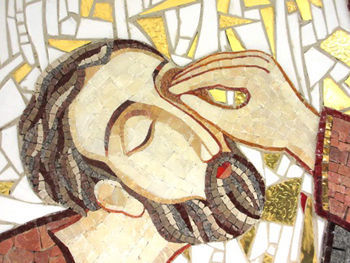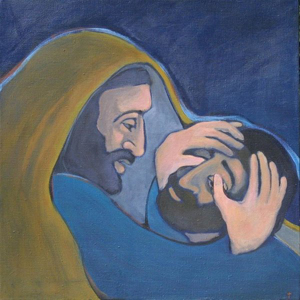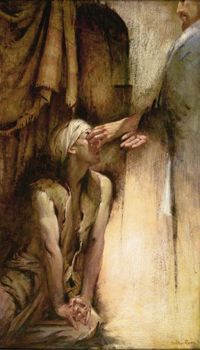For Sunday March 22, 2020
Lectionary Readings (Revised Common Lectionary, Year A)
1 Samuel 16:1-13
Psalm 23
Ephesians 5:8-14
John 9:1-41
How quickly the world changes. When I started working on this essay a couple of weeks ago, the children in my town were attending school, local businesses were open and thriving, the shelves in my local grocery store were well-stocked, the church I attend was gearing up for Holy Week, my daughter was enjoying a semester abroad in Ireland, my husband — an E.R physician — was experiencing fairly normal workdays, and I had never heard the phrase, “social distancing.”
Now, just days later, schools and universities around the country are closed. Libraries, restaurants, cafes, and cultural centers are shutting their doors. I can’t find hand sanitizer, bathroom tissue, or other staples at the local grocery. My church will offer worship services online for at least the next month. My daughter is flying home, ahead of a federally mandated travel ban between the United States and Europe. My husband’s experiences in the emergency room have drastically changed, and I am learning to maintain a three to six foot distance from every human being I encounter. Welcome to life in the shadow of Covid-19. Like I said, how quickly the world changes.
Or maybe “change” isn’t the right word. I've heard people use the word “apocalyptic” to describe what life feels like right now, and I'm wondering if that's the better word. After all, an apocalypse, rightly defined, is an unveiling, a revelation of things previously unseen or unknown. Maybe the world hasn’t changed so much as it has been exposed, uncovered, made plain, laid bare. Maybe we were blind before, and the time has now come to see.
To see what, exactly? That we are fragile. That we are one — interdependent and interconnected. That our daily choices can have life-and-death consequences for other people. That unselfish love is risky, inconvenient, and essential. That so much more is at stake in our spiritual lives than our personal safety and comfort. That we are supposed to be people of the Cross, even as we are also people of the Resurrection.
Our Gospel story for this fourth week of Lent is about costly seeing. One of my favorite poems, “The Place Where We Are Right,” by Israeli poet, Yehuda Amichai, captures what I believe is the heart of the Gospel's message:
From the place where we are right
Flowers will never grow
In the spring.The place where we are right
Is hard and trampled
Like a yard.But doubts and loves
Dig up the world
Like a mole, a plow.
And a whisper will be heard in the place
Where the ruined
House once stood.
In John’s Gospel, Jesus heals a “ruined” man on the Sabbath, a man who has been blind since birth. When Jesus sees him, he kneels down, spits on the ground, makes a muddy paste with his saliva, rubs the paste on the man’s eyes, and instructs him to go and wash in the pool of Siloam. When the man obeys, his sight is restored.
 |
Though this is a miracle story, the Gospel writer doesn’t spend too long on the healing itself. The focus of the lection is on the religious community’s response, both to the man’s blindness, and to his restored sight. And it is in the response that I think Amichai’s poem resonates, speaking powerfully to the challenges of our own time and place. “From the place where we are right,” the poet says, “flowers will never grow in the spring.” In other words, one of the most barren and desolate places we can occupy as Christians is a place of smugness. Of rightness. Of certainty. The more convinced we are that we have full insight, comprehension, and knowledge, the less we will see and experience of God.
Even before Jesus heals the blind man, the disciples assume that his blindness is his own fault. So they ask Jesus who has sinned and incurred God’s displeasure — the man himself, or his parents. But Jesus rejects the entire premise of their question. There is no relationship between the man’s condition and his sinfulness, Jesus says. God does not make people sick in order to punish them for wrongdoing. To step away from our brother or sister’s suffering because we assume it’s divinely ordained, is not righteous. It’s reprehensible.
In the story John tells, Jesus sees the blind man — a man whom no one else really sees. In the eyes of his peers, the man is contaminated, burdensome, and expendable. In his community’s calculus of human worth, the blind man barely registers — he’s not a human being; he’s Blindness. The condition itself, with all of its accumulated meanings. Which is why, when the man’s sight is restored by Jesus, his own townspeople — the people he has lived and worshipped with for years — don’t recognize him. They don’t know how to see him without his disability. To do so would be to recognize a common humanity, a bond, a kinship. And that would be intolerable.
So, of course, when the man shows up at the Temple healed and whole, the community rallies to discredit him. To restore order, re-establish the social hierarchy, and reinforce the status quo.
But why? Why does the community feel such an urgent need to silence the healed man? I wonder if the core reason is fear. A fear so primal and so deep, it drives away all compassion, all empathy, all tenderness, all sense of kinship. If the man’s blindness isn’t a punishment for sin, then what does that mean about how the world works? Anyone might get sick, or suffer from a disability, or face years of undeserved pain and suffering for no discernible reason whatsoever. That wouldn’t be fair — would it? That would be a version of reality the good religious folks can’t control. A terrifying, destabilizing version. Who among us can bear to surrender the illusion of control?
 |
Not only does the community’s legalistic approach to faith prevent them from seeing the healed man; it also prevents them from seeing God’s love and power at work in their midst. No one in the story rejoices when the man is healed. No one – not even the man’s parents — expresses joy, or wonder, or gratitude, or awe. No one says, “I am so happy for you!” or asks, “What is it like to see for the first time? Does the sunlight hurt your eyes? What are you excited to look at first?”
Instead, the community responds with contempt, its need to preserve its own sense of righteousness more important than celebrating a fellow human being’s restoration to life. “The place where we are right,” the poem says, is “hard and trampled like a yard.” Hard and cynical. Hard and suspicious. Hard and stingy.
This suggests to me that vulnerability, softness, curiosity, and openness are essential to real seeing. The Gospels tell us that Jesus’s true identity eludes just about everyone until after his Resurrection. Even his disciples struggle to understand who and what their Teacher is. Most of the people who encounter Jesus are too busy seeing what they want to see — a magician, a heretic, a political and military leader, a carpenter’s son, a wise man, a phony, a clerical threat — to notice what the blind man, free of all such filters, discerns by the end of the story. The blind man alone sees Jesus as the Son of Man and calls him, “Lord.”
We might say, then, that this is one of the rare and beautiful moments in the Gospels when Jesus himself is truly seen. The blind man sees Jesus as wholly and purely as Jesus sees him; the gaze and the recognition in this story are mutual. Because the healed man has no preconceptions, because the spiritual ground he stands on is soft and supple, he is able to see God as God is. “Doubts and loves dig up the world, like a mole, like a plow.” They allow the whispers of God’s Spirit to bring forth new life.
Whether we want to or not over the coming weeks, we will face a choice — the choice to see or to turn away. Will we allow the ground we stand on to remain pliable, or will we harden our stance and refuse to grow and change?
During these hard days, who are the people we might render invisible with our cherished theologies, our dogmatic political views, our legalistic approaches to justice, fairness, generosity, and sympathy? Who might we deem expendable during this season of mass illness and fear? Whose joys will we be unwilling to celebrate, because we’re so busy hoarding our own?
 |
Will we be flexible in the ways we extend love across distances, or will we hunker down in fear and suspicion? Will we dare to be the Church in new ways, even as we practice quarantines and social distancing — or will we forget that we are one body, connected and interdependent, incomplete without each other? Will we have eyes to see God in our neighbors, regardless of whether they are sick or healthy, insured or uninsured, citizen or foreigner, protected or vulnerable? Will we be brave enough to look our own vulnerability — our own mortality — in the eye, and trust that God is with us even in the valley of the shadow of death? Or will we yield to cynicism, panic, and despair?
I am in awe of the trust the healed man has in Jesus by the end of this week’s Gospel story — a trust deep enough to enable him to bear honest, radical witness to his experience, even at the risk of censure and excommunication from his religious community. In shedding his identity as “the man blind from birth,” the healed man becomes a disciple, a traveler, a pilgrim. He commits himself without looking back, straining forward instead of clinging to what others tell him is right and true. He is, in the truest sense, born again.
During this Lenten season, may we, too, confess our blindness and receive sight. May we also praise the one who kneels in the dirt and gets his hands dirty in order to heal us. May we also soften and prepare the ground we stand on, so that when new life appears in whatever surprising guise God chooses, we will embrace, cherish, celebrate, and share the good news, too.
Debie Thomas: debie.thomas1@gmail.com
Image credits: (1) PoliNation; (2) The Upper Room; and (3) Walter Rane Prints.





